Right first thing first – safety! In this process you will be working with highly caustic ingredients and hot oil. Eye protection and rubber gloves must be used at all times – chemical burns and hot oils must not be treated lightly. Concentration, accuracy and focus are an absolute must. With all seriousness, I will not make soap when there are children or pets around the place – it’s a job for peace and quiet. Fumes will be given off from dissolving caustic soda – please ensure you are working in a well-ventilated environment.
Measurement. All soap making is done by weight – never volume (other than essential oils and other perfumes which are only additives). If I describe using 11 ounces of water I mean 11 ounces by weight NOT fluid ounces. This is critical.
Soap making is, in reality, a simple process. A strong alkali solution is added to a fat “base” at matched temperatures. A chemical reaction occurs (saponification) and the alkali and fat cease to exist and are replaced by soap. Its important to understand that this a reaction not a mixing process. If the ingredients are not in the correct proportions then the reaction will not occur completely with potentially dangerous results. Too much alkali and the soap produced will contain unreacted alkali – this has the potential to cause chemical burns. Too much fat and there will be insufficient alkali to turn it all to soap leaving a mix of fat and soap that will turn rancid.
The alkali generally used is caustic soda (sodium hydroxide). This is widely available from hardware stores as a cleaning product. The tricky part of this is that each fat needs a different amount of alkali to turn it into soap. There are tables of the relative amounts of caustic soda required for each type of fat known as “saponification charts” to ensure you use precisely the right amount.
I have taken a few photos whilst making soap recently to help illustrate the process. I actually photographed a couple of different batches using different recipes and have taken some pictures from both batches – so don’t worry that some photos show a yellow soap and some a “speckly” soap – its not changing colour, its just a different batch.
Right – lets see what to do
Step 1 – Assemble Ingredients.
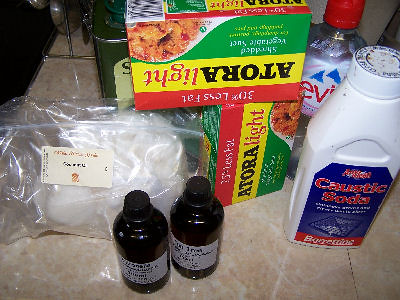
You will need
A fat base
Caustic Soda
Mineral Water (still)
A good basic soap can be made from
16oz of either lard or vegetable suet
2oz of caustic soda
5oz of still mineral water
You may in addition wish to add a scent to you soap. A good quality essential oil is the best product to use for this (10ml is an average amount). If you wish to make a nice “scrubby” texture a tablespoon of fine oatmeal can be added.
Step 2 – Assemble Equipment
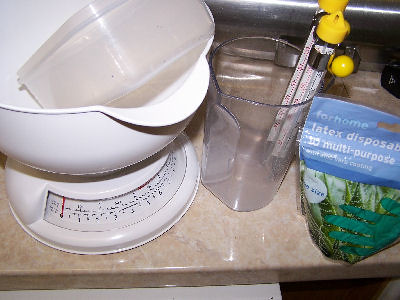
You will need
An accurate set of scales (in easily readable 1oz increments)
An enamel or stainless steel saucepan
A wooden spoon to stir
2 high temperature thermometers (jam making thermometers are good)
Some moulds for your soap (plastic takeaway containers, yoghurt pots something like that)
Containers to weigh your caustic soda and water in
A couple of old towels
A sharp knife to cut your soap into bars
Rubber gloves
Eye protection
Step 3 - Weigh Fats
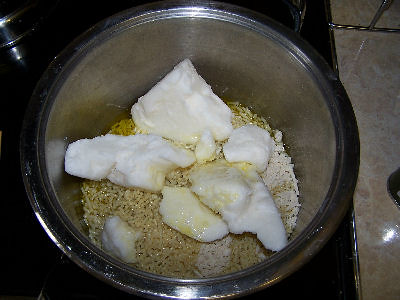
Weight out your fats and place them into a stainless pan. I prefer to use an old pan that I keep for soap making (this is true of all my soap making gear).
Step 4 – Weigh Alkali
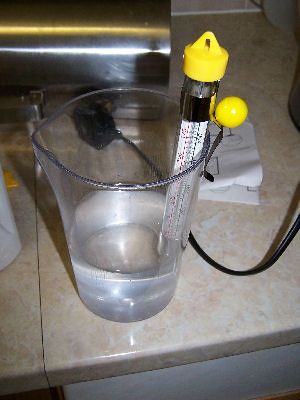
Make sure you have hand an eye protection on here. Weigh out your caustic soda and water (in separate containers). Carefully pour the caustic soda into the water. DO NOT let the solution splash you or inhale the fumes – I mean it! Stir the solution gently and pop a thermometer in. The temperature will rise to a very high temperature as the caustic soda reacts to the water. We need it to fall before we add it to the fat.
Step 5 – Melt Fat
![url]](http://[url]http://farm3.static.flickr.com/2283/1743563616_df9fcccb43.jpg[/url])
Put your fat base on a low heat. We aren’t cooking chips here – just gently melting the fats. Stir gently with a wooden spoon to ensure all the fats melt and don’t stick or burn.
Whilst this is melting, lightly grease you moulds (you will need these later)
Step 6 – Check Temperature
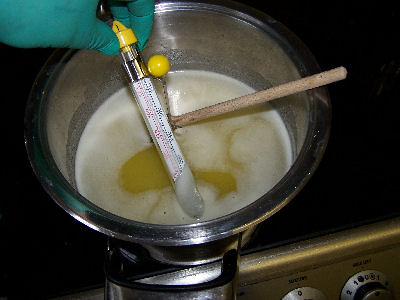
Once your fat has melted remove the pan from the heat. Put a second thermometer into the fat and check the temperature. We need the fat and caustic solution to be at the same temperature between 120 and 140 F. Allow both to cool until they are the same temperature in this range.
Step 7 – Mix
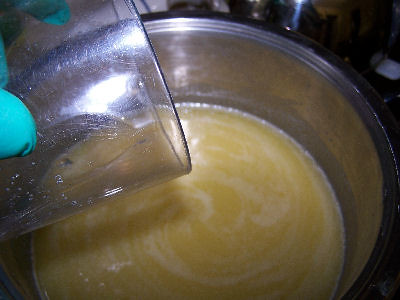
When the caustic solution and fat are at the same temperature around 130F, CAREFULLY pour the caustic soda solution into the melted fats stirring gently. Note the fetching green gloves J
Step 8 – “Trace”
Now we have to stir the mixture firmly (without splashing). It needs to be stirred as often as possible until the mixture starts to thicken enough that when some is trickled back into the pot it eaves the trace of a line on the surface. This is called “trace”. This will take about 30 to 60 minutes – sometimes longer stirring frequently. Alternatively, a stick blender can get you to “trace” in less than 60 seconds! I have a cheap one I reserve for soap making.
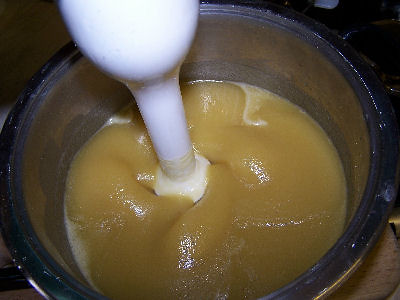
Step 9 – Extras.
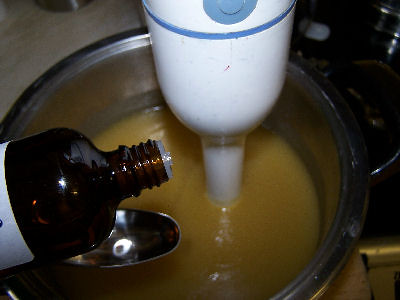
If you wish to add essential oil, oatmeal, dried seaweed or any other ingredients that enhance scent and texture, now is the time. Add them in, and give the mixture a good stir
Step 10 – pour into moulds
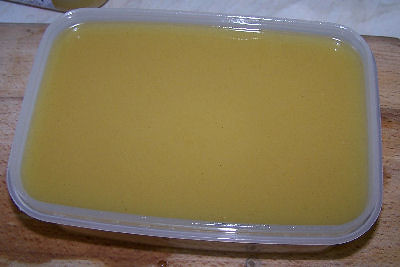
Carefully pour your soap into your greased moulds. Cover the mould with an old towel or blanket and leave the soap for 24 hours to set.
Step 11 – turn out
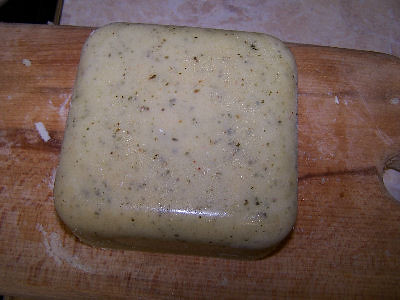
Put your gloves back on! Carefully flex the mould and turn out your set soap onto an old board. The soap is still caustic and will be for a month. Do NOT touch with bare skin for four weeks yet. Its set but the chemical reaction is still going on. You may notice the soap feels warm if your gloves are thin – this is the “exothermic” nature of the reaction
Step 12 – Slice
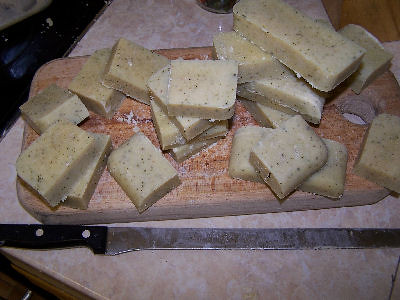
Still wearing your gloves, take a large knife (I have an old ham knife that’s ideal). Take the cut bars and wrap in old towels or blankets for 4 weeks.
After 4 weeks test the soap on a small area of skin in case you messed up! It should be fine, but always with soap – safety first.
Remember that you will have messy pans, moulds knives and boards in this process. They must be scoured clean in warm water and detergent still wearing gloves since the soap residue on them is still caustic.
That’s all there is to it really. Its pretty straightforward and anyone can do it. I may have harped on a lot about safety – its not precisely dangerous if you are careful but of you are careless you could get hurt. With common sense though you can make fantastic soaps at a fraction of the price they cost to buy.
On a personal note, please never use palm oil in soap. Its commonly used by big companies but is not necessary and leads to deforestation and monoculture farming that is ruinous to wildlife.
Have Fun!
Red
Measurement. All soap making is done by weight – never volume (other than essential oils and other perfumes which are only additives). If I describe using 11 ounces of water I mean 11 ounces by weight NOT fluid ounces. This is critical.
Soap making is, in reality, a simple process. A strong alkali solution is added to a fat “base” at matched temperatures. A chemical reaction occurs (saponification) and the alkali and fat cease to exist and are replaced by soap. Its important to understand that this a reaction not a mixing process. If the ingredients are not in the correct proportions then the reaction will not occur completely with potentially dangerous results. Too much alkali and the soap produced will contain unreacted alkali – this has the potential to cause chemical burns. Too much fat and there will be insufficient alkali to turn it all to soap leaving a mix of fat and soap that will turn rancid.
The alkali generally used is caustic soda (sodium hydroxide). This is widely available from hardware stores as a cleaning product. The tricky part of this is that each fat needs a different amount of alkali to turn it into soap. There are tables of the relative amounts of caustic soda required for each type of fat known as “saponification charts” to ensure you use precisely the right amount.
I have taken a few photos whilst making soap recently to help illustrate the process. I actually photographed a couple of different batches using different recipes and have taken some pictures from both batches – so don’t worry that some photos show a yellow soap and some a “speckly” soap – its not changing colour, its just a different batch.
Right – lets see what to do
Step 1 – Assemble Ingredients.

You will need
A fat base
Caustic Soda
Mineral Water (still)
A good basic soap can be made from
16oz of either lard or vegetable suet
2oz of caustic soda
5oz of still mineral water
You may in addition wish to add a scent to you soap. A good quality essential oil is the best product to use for this (10ml is an average amount). If you wish to make a nice “scrubby” texture a tablespoon of fine oatmeal can be added.
Step 2 – Assemble Equipment

You will need
An accurate set of scales (in easily readable 1oz increments)
An enamel or stainless steel saucepan
A wooden spoon to stir
2 high temperature thermometers (jam making thermometers are good)
Some moulds for your soap (plastic takeaway containers, yoghurt pots something like that)
Containers to weigh your caustic soda and water in
A couple of old towels
A sharp knife to cut your soap into bars
Rubber gloves
Eye protection
Step 3 - Weigh Fats

Weight out your fats and place them into a stainless pan. I prefer to use an old pan that I keep for soap making (this is true of all my soap making gear).
Step 4 – Weigh Alkali

Make sure you have hand an eye protection on here. Weigh out your caustic soda and water (in separate containers). Carefully pour the caustic soda into the water. DO NOT let the solution splash you or inhale the fumes – I mean it! Stir the solution gently and pop a thermometer in. The temperature will rise to a very high temperature as the caustic soda reacts to the water. We need it to fall before we add it to the fat.
Step 5 – Melt Fat
![url]](http://[url]http://farm3.static.flickr.com/2283/1743563616_df9fcccb43.jpg[/url])
Put your fat base on a low heat. We aren’t cooking chips here – just gently melting the fats. Stir gently with a wooden spoon to ensure all the fats melt and don’t stick or burn.
Whilst this is melting, lightly grease you moulds (you will need these later)
Step 6 – Check Temperature

Once your fat has melted remove the pan from the heat. Put a second thermometer into the fat and check the temperature. We need the fat and caustic solution to be at the same temperature between 120 and 140 F. Allow both to cool until they are the same temperature in this range.
Step 7 – Mix

When the caustic solution and fat are at the same temperature around 130F, CAREFULLY pour the caustic soda solution into the melted fats stirring gently. Note the fetching green gloves J
Step 8 – “Trace”
Now we have to stir the mixture firmly (without splashing). It needs to be stirred as often as possible until the mixture starts to thicken enough that when some is trickled back into the pot it eaves the trace of a line on the surface. This is called “trace”. This will take about 30 to 60 minutes – sometimes longer stirring frequently. Alternatively, a stick blender can get you to “trace” in less than 60 seconds! I have a cheap one I reserve for soap making.

Step 9 – Extras.

If you wish to add essential oil, oatmeal, dried seaweed or any other ingredients that enhance scent and texture, now is the time. Add them in, and give the mixture a good stir
Step 10 – pour into moulds

Carefully pour your soap into your greased moulds. Cover the mould with an old towel or blanket and leave the soap for 24 hours to set.
Step 11 – turn out

Put your gloves back on! Carefully flex the mould and turn out your set soap onto an old board. The soap is still caustic and will be for a month. Do NOT touch with bare skin for four weeks yet. Its set but the chemical reaction is still going on. You may notice the soap feels warm if your gloves are thin – this is the “exothermic” nature of the reaction
Step 12 – Slice

Still wearing your gloves, take a large knife (I have an old ham knife that’s ideal). Take the cut bars and wrap in old towels or blankets for 4 weeks.
After 4 weeks test the soap on a small area of skin in case you messed up! It should be fine, but always with soap – safety first.
Remember that you will have messy pans, moulds knives and boards in this process. They must be scoured clean in warm water and detergent still wearing gloves since the soap residue on them is still caustic.
That’s all there is to it really. Its pretty straightforward and anyone can do it. I may have harped on a lot about safety – its not precisely dangerous if you are careful but of you are careless you could get hurt. With common sense though you can make fantastic soaps at a fraction of the price they cost to buy.
On a personal note, please never use palm oil in soap. Its commonly used by big companies but is not necessary and leads to deforestation and monoculture farming that is ruinous to wildlife.
Have Fun!
Red



 :notworthy
:notworthy